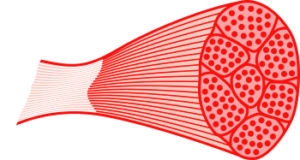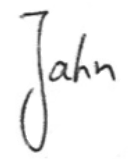Muscle Building Workout
Hypertrophy is by far the most popular form of training for most fitness students. This is not surprising because hypertrophy training has a reputation for being particularly suitable if you want to build muscle effectively. In fact, when used correctly, it has earned this reputation.
The problem, however, is that many people don’t know the background and therefore don’t know what to look out for during exercise. This can lead to errors and sub-optimal learning outcomes. For this reason, I wrote the following article to let you know why, when, and how you can optimally use hypertrophy training for strength training. This way, you can reduce the duration of muscle building to a minimum.
In today’s article, I will answer the most important questions I am constantly asked about hypertrophy training. Among other things, you will learn:
Hypertrophy training definition
The term hypertrophy medically describes an increase in the size of an organ (such as muscle) or tissue due to cell enlargement (see the definition of hypertrophy on Wikipedia). Hypertrophy is one of two forms of organic growth, the other is hyperplasia. While the volume of cells increases with hypertrophy, the number of cells increases with hyperplasia. In strength training, hypertrophy is also called muscle growth.
Hypertrophy is training in such a way that the maximum possible increase in muscle cross-section can be achieved. It works through a specific workout with the correct intensity and regeneration times.
Peptides are becoming more and more popular in bodybuilding every year. It is not surprising that both novice athletes and professionals are eager to buy peptides. Peptides Ukraine
If you’re training to build muscle, you probably need two things: more strength and more muscle. A type of workout that specifically stimulates muscle growth is the first choice for this purpose. In addition, muscle cross-section is also a critical factor in muscle strength.
There is no scientific evidence for the only alternative, hyperplasia. In theory, both types of growth can be induced by specific muscle stress, but muscle growth through hyperplasia can only be demonstrated in experiments on individual animals. This growth cannot be induced in people without steroid use. This means that there is no alternative to muscle hypertrophy to naturally increase muscle mass.

Only through muscle hypertrophy Proven increase in muscle cross-section.
If your strength training is mainly about increasing strength and decreasing muscle mass, then you should also do maximum strength training.
Correct intensity is important
Hypertrophy is performed with a relatively high training intensity. Various studies suggest a performance range of around 70-80% for maximum effect. This roughly corresponds to the number of reps 8-12 reps. However, there is also literature that suggests a more generous power range of 60-85% of maximum strength, which corresponds to a rep range of 6-15 reps.
Personally, I’ve had the best experience in the 6-10 rep range. As soon as I do 10 or more reps, I will increase the weight the next time. If I can’t do 6 reps with one weight, then the weight needs to be reduced, even if it’s difficult for me sometimes.
Unlike strength endurance training, the crosshair should be smaller during high intensity training. To do this, you must take your breaks between sets a little longer. Always give your muscles 2-3 minutes to recover between sets when training hypertrophy. It is best to use a workout timer.
Sufficient training volume for effective muscle growth
Besides intensity, training volume also plays a critical role in the development of muscle hypertrophy through muscle training. Your muscles will only be stimulated for growth if enough muscle volume is stimulated with enough exercise.
The basic principle of volume is “the more the better”. However, there is a minimum amount to start muscle growth. For large muscle groups, this is about ten working sets per week. In fact, this also applies to smaller muscles, which, however, are already used during the training of the main muscles.
With about six work sets per muscle group and exercise and eight per muscle group and training unit, the marginal benefit is already quite small. In terms of efficiency, you should not exceed this volume. Otherwise, perhaps for slightly more muscle gains, you run a much greater risk of overtraining.
Is it possible to train hypertrophy with your own body weight?
I’ve heard this question many times. Doubts are obvious, as with a little training experience you can quickly do more than 10 reps with classic bodyweight exercises. Even with a demanding chin workout, you fall into the double-digit range with some practice.
But it’s entirely possible that your muscles will fail with a few reps, even with some training experience. There are different approaches to this:
If you want to know more about this topic, I recommend my article “Effective Muscle Building – Bodyweight Strength Training”.
Hypertrophic Training is (also) beneficial in the diet
Hypertrophy training as training to maximize muscle growth at first seems rather mild in the context of a reduction diet. In fact, hypertrophy training is the best way to lose as little muscle as possible on such a diet. Ultimately, when you are losing weight, you want to lose fat and maintain your muscles, if possible. Contrary to common misconceptions, hypertrophy is the preferred treatment if you want to define muscles.
In addition to adequate and proper exercise, it is also important to maintain muscle as well as an increased protein intake of at least 2.5 to 3 grams of protein per kilogram of body weight. One or the other protein shakes may be beneficial for supplementation.

You shouldn’t always train just for hypertrophy
A lot helps a lot, you might think, and because of the benefits of hypertrophy training, you can just train hard on this principle. In fact, many strength lifting enthusiasts do just that and seem to have great success. However, most of them are unaware of the possibility that a different approach could lead to even greater success. Lest you feel this way, I would like to suggest a more versatile design for your workout planning at this stage.
In fact, changes and changes in your type of learning are good and important for your learning. By regularly training your strength endurance and maximum strength, you reap various benefits. It can have a positive impact on your psyche, health and even muscle growth.
It is better to read the following articles to learn more about the meaning of these two alternative learning types:
It is therefore very important to have a good medium to long term learning plan that will quickly bring you closer to your goal.
What does a good hypertrophy learning plan look like?
A good hypertrophy training plan is actually pretty simple. The same requirements apply to exercises as to any other strength training plan. A good combination of challenging basic exercises such as squats, convertibles, or shoulder presses as a foundation for muscle building and selective focus. Isolation exercises to focus on specific areas. Most importantly, you choose the difficulty level of the exercises so that your muscles are exhausted after about 6-10 reps.
As always, it all comes down to balanced training of different muscle groups. Otherwise, of course, you can develop your muscle training plan as a full body workout or as a split workout.
Our free beginner and advanced workout plans are of course also very suitable for strength endurance training. To our curriculum.
Your conclusion on hypertrophy training
As you can see, good and effective hypertrophy workout is not rocket science, and it really propels you forward when it comes to building muscle.
I hope I was able to answer some of your questions in this article and help you use it even more effectively when planning your workouts in the future. Always keep in mind that the correct learning approach is also necessary when using this learning principle, and that it makes sense to alternate regularly with other types of learning.
If you don’t want to waste any more time and want to start building muscle now, check out my book The Basics of Building Muscle. It summarizes the most important things you need to know and take into account to build muscle. This is the first true guide to effective muscle building. There are also my most effective workout plans for building muscle quickly.
Until then, good luck with your training!

And don’t forget: your health is your health.
